Di patho - Study guides, Class notes & Summaries
Looking for the best study guides, study notes and summaries about Di patho? On this page you'll find 99 study documents about Di patho.
All 99 results
Sort by
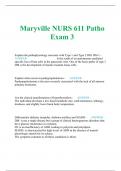
-
Maryville NURS 611 Patho Exam 3 Explain the pathophysiology associate with Type 1 and Type 2 DM. DM 1 - ANSWER - Is the result of an autoimmune mediated specific loss of beta cells in the pancreatic islet. On
- Exam (elaborations) • 12 pages • 2024
- Available in package deal
-
- $11.49
- + learn more
Maryville NURS 611 Patho Exam 3 Explain the pathophysiology associate with Type 1 and Type 2 DM. DM 1 - ANSWER - Is the result of an autoimmune mediated specific loss of beta cells in the pancreatic islet. One of the basic patho of type 2 DM is the development of insulin resistant tissue cells. Explain what occurs in panhypopituitarism - ANSWER - Panhypopituitarism is the term correctly associat...
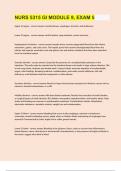
-
NURS 5315 GI MODULE 9, EXAM 5|2023/24 UPDATE|GRADED A+
- Exam (elaborations) • 9 pages • 2023
-
Available in package deal
-
- $13.49
- 1x sold
- + learn more
Upper GI organs mouth,pharynx, esophagus, stomach, and duodenum Lower GI organs small intestine, large intestine, rectum and anus Hepatoportal circulation hepatic artery receives oxygenated blood from the inferior mesenteric, gastric, and cystic veins. The hepatic portal vein receives deoxygenated blood from the inferior and superior mesenteric vein and splenic vein and delivers nutrients that have been absorbed from the intestinal system Osmotic diarrhea Caused by the p...
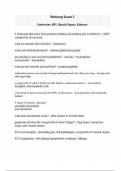
-
ATI Medsurg Exam 3 - Endocrine, HIV, Shock/Sepsis, Kidneys
- Exam (elaborations) • 13 pages • 2024
-
- $10.00
- + learn more
3 hormones that come from posterior pituitary (everything else is anterior!) - ADH, vasopressin, & oxytocin what are steroids derived from? - cholesterol where are steroids produced? - adrenal glands and gonads are steroids or non-steroids hydrophobic? - steroids = hydrophobic non-steroids = hydrophilic what are non-steroids derived from? - proteins/peptides endocrine tumors are usually benign/malignant and slow/fast-growing - benign and slow-growing overgrowth of what 3 kinds of cells ...
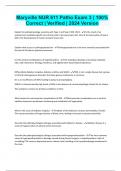
-
Maryville NUR 611 Patho Exam 3 | 100% Correct | Verified | 2024 Version
- Exam (elaborations) • 8 pages • 2024
- Available in package deal
-
- $8.49
- + learn more
Explain the pathophysiology associate with Type 1 and Type 2 DM. DM 1 - Is the result of an autoimmune mediated specific loss of beta cells in the pancreatic islet. One of the basic patho of type 2 DM is the development of insulin resistant tissue cells. Explain what occurs in panhypopituitarism - Panhypopituitarism is the term correctly associated with the lack of all anterior pituitary hormones. List the clinical manifestations of hypothyroidism - The individual develops a low basal metab...
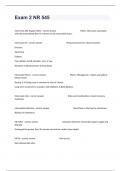
-
Exam 2 NR 545 Complete Questions With 100% Guaranteed Verified Solutions.
- Exam (elaborations) • 18 pages • 2024
-
Available in package deal
-
- $13.99
- + learn more
Chest Pain AKA Angina Patho - correct answer Patho: Chest pain associated with decreased blood flow or ischemia to the myocardial tissue. Chest pain PA - correct answer Physical Assessment: chest heaviness Pressure Squeezing Fullness Pain radiates to left shoulder, arm, or jaw. Elevation of blood pressure during attack Chest pain Pharm - correct answer ...
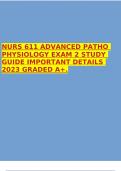
-
NURS 611 ADVANCED PATHO PHYSIOLOGY EXAM 2 STUDY GUIDE IMPORTANT DETAILS 2023 GRADED A+.
- Exam (elaborations) • 25 pages • 2023
-
- $13.49
- + learn more
NURS 611 ADVANCED PATHO PHYSIOLOGY EXAM 2 STUDY GUIDE IMPORTANT DETAILS 2023 GRADED A+. Week 4 Neurological Functions: chapters 16, 17, 18 & 19 Central Nervous System- Brain & spinal cord I. Brain * Ability to reason, function intellectually, express personality & mood, perceive & interact with the environment A. Forebrain (telencephalon: cerebral hemispheres & diencephalon: interbrain) a. Cerebral cortex (largest portion of the brain) b. Basal ganglia (several nuclei) c. Cerebral co...
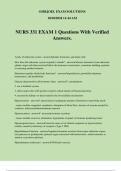
-
NURS 331 EXAM 1 Questions With Verified Answers.
- Exam (elaborations) • 33 pages • 2024
-
- $11.49
- + learn more
NURS 331 EXAM 1 Questions With Verified Answers. 3 parts of endocrine system - answerglands, hormones, and target cells How does the endocrine system respond to stimuli? - answerreleases hormones from endocrine glands; target cells then read and follow the hormone's instructions, sometimes building a protein or releasing another hormone Hormones regulate which body functions? - answerreproduction, growth/development, homeostasis, and metabolism General characteristics all hormones sha...
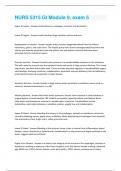
-
NURS 5315 GI Module 9, exam 5 (100% correct and graded A+)
- Exam (elaborations) • 9 pages • 2024
- Available in package deal
-
- $7.99
- + learn more
Upper GI organs - Answer-mouth,pharynx, esophagus, stomach, and duodenum Lower GI organs - Answer-small intestine, large intestine, rectum and anus Hepatoportal circulation - Answer-hepatic artery receives oxygenated blood from the inferior mesenteric, gastric, and cystic veins. The hepatic portal vein receives deoxygenated blood from the inferior and superior mesenteric vein and splenic vein and delivers nutrients that have been absorbed from the intestinal system Osmotic diarrhea - Answe...
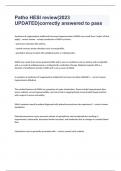
-
Patho HESI review(2023 UPDATED)correctly answered to pass
- Exam (elaborations) • 17 pages • 2023
- Available in package deal
-
- $12.99
- + learn more
Patho HESI review(2023 UPDATED)correctly answered to passSyndrome of inappropriate antidiuretic hormone hypersecretion (SIADH) may result from: (select all that apply) - correct answer - ectopic production of ADH by tumors - pulmonary disorders like asthma. - central nervous system disorders such as encephalitis. - psychiatric disease treated with antidepressants or antipsychotics. SIADH may result from tumor-produced ADH and is seen in conditions such as asthma and encephalitis and as a r...
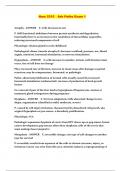
-
Nurs 5315 Adv Patho Exam 1
- Exam (elaborations) • 68 pages • 2024
-
- $11.99
- + learn more
Atrophy - ANSWER E. Cells decrease in size P. Still functional; imbalance between protein synthesis and degradation. Essentially there is an increase in the catabolism of intracellular organelles, reducing structural components of cell Physiologic: thymus gland in early childhood Pathological: disuse (muscle atrophy d/ decrease workload, pressure, use, blood supply, nutrition, hormonal stimulation, or nervous stimulation) Hyperplasia - ANSWER E: cells increase in number, mitosis (cell div...

Do you wonder why so many students wear nice clothes, have money to spare and enjoy tons of free time? Well, they sell on Stuvia! Imagine your study notes being downloaded a dozen times for $15 each. Every. Single. Day. Discover all about earning on Stuvia


